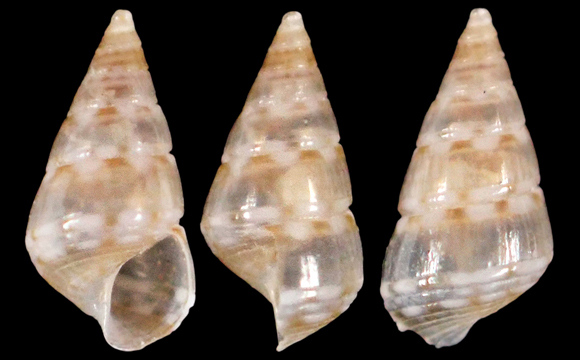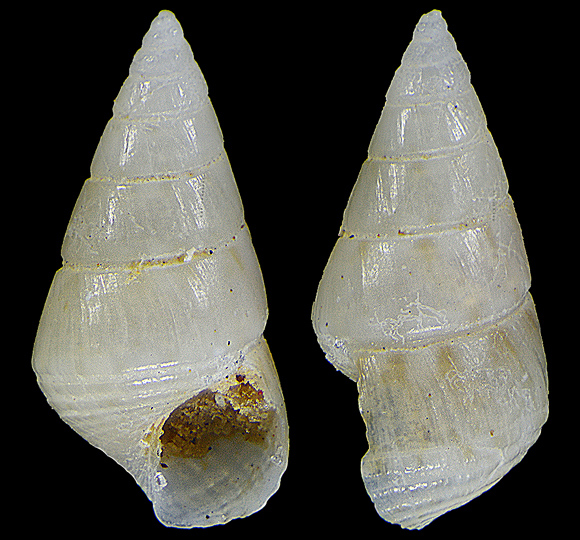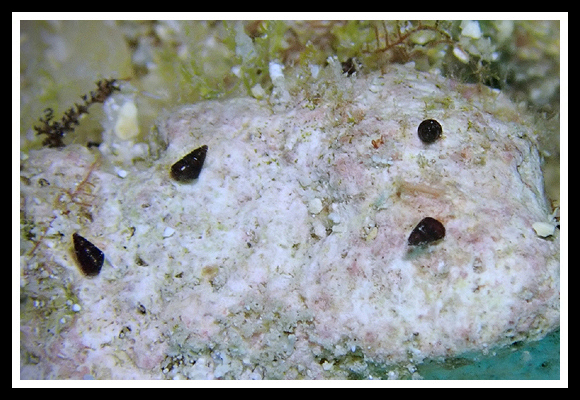
Due to its wide distribution and high variability, semistriata has been discovered many times, hence the numerous synonyms that are attached to this taxon: basispiralis, cacumenata, conica, imbricata, infrasulcata, macula, planalba, polita, scitula, trilirata, varia, variegata, vestigia, watsoni… Not surprisingly, the veliger is planktotrophic.
« Protoconch conical, of 2.2-2.5 regularly increasing rounded whorls; protoconch I about 1 whorl, smooth; protoconch II lacking definite sculpture except for weak growth lines and narrow spiral ridge in middle of whorl; colour white to yellow or brown, rarely purple; strongly sinusigerate varix, forming narrow to thickened raised edge adapically, comprised of one to a few layers, rounded to subangled in middle of whorl, simple abapically. Teleoconch with up to 8 very lightly convex whorls, first 1-5 whorls with 2 heavy, rounded spiral ribs and weak axial and spiral threads; weak to moderately strong pustules sometimes present in interspaces between spirals on upper whorls; remainder of spire whorls smooth except for inconspicuous axial growth lines. Base lightly convex, with 6-11 spiral lirae separated by grooves ranging from about equal in width to lirae to linear. » – Ponder & de Keyzer: “A revision of the genus Diala (Gastropoda; Cerithioidea; Dialidae)”, Invertebrate Taxonomy vol.6, 1992, p.1028.
« Protoconch conical, of 2.2-2.5 regularly increasing rounded whorls; protoconch I about 1 whorl, smooth; protoconch II lacking definite sculpture except for weak growth lines and narrow spiral ridge in middle of whorl; colour white to yellow or brown, rarely purple; strongly sinusigerate varix, forming narrow to thickened raised edge adapically, comprised of one to a few layers, rounded to subangled in middle of whorl, simple abapically. Teleoconch with up to 8 very lightly convex whorls, first 1-5 whorls with 2 heavy, rounded spiral ribs and weak axial and spiral threads; weak to moderately strong pustules sometimes present in interspaces between spirals on upper whorls; remainder of spire whorls smooth except for inconspicuous axial growth lines. Base lightly convex, with 6-11 spiral lirae separated by grooves ranging from about equal in width to lirae to linear. » – Ponder & de Keyzer: “A revision of the genus Diala (Gastropoda; Cerithioidea; Dialidae)”, Invertebrate Taxonomy vol.6, 1992, p.1028.
Gwakji beach, Aewol-eup, northwestern coast of Jeju Island, South Korea. Original pictures provided by Doyeon K. for iNaturalist – (CC BY-NC).

« Suture indented, narrowly channelled, channel wider in last two whorls in some specimens, sometimes with upper basal spiral visible. Aperture ovate-pyriform, sharply angled posteriorly, bluntly angled anteriorly; inner lip thin, narrow; outer lip prosocline […] straight posteriorly, anterior edge rounded, joins inner lip at right angle. Shell, when fresh, translucent with white and light orange-brown markings; each whorl with alternate white and orange-brown flame-like markings abapical to suture extending ⅓ width of each whorl (up to ½ whorl on body whorl) and expanding abapically; each whorl also typically with checkerboard pattern of small white spots outlined in brown above white and brown alternate banding and row of brown square patches widely interspaced with white before suture of each whorl. Inner lip orange to brown. » – Ibid. The subsutural pattern of alernatively coloured and white blotches is, indeed, constant, as well as the basal striations. Above, a pale and probably faded specimen from Ashdod, South District, W. Israel. 2,58mm.
Source: gruppomalacologicoscalaria.org.
Original pictures provided by A. Nappo (IT).
– (CC BY-NC-SA) –

« Colour of shell in some populations varying from dark red-brown with no distinct markings (especially juveniles) to almost pure white. Typically with light orange-brown rectangular blotches regularly positioned along top of each whorl […] or a single axial line or a cluster of axial lines radiating from a central point […], which in all forms originates at the suture. » – Op. cit. p.1029-1030.
Dark shells from Oahu Island, Hawaii Archipelago. Original image provided by D. Torres-Pulliza for iNaturalist.
– (CC BY-NC) –